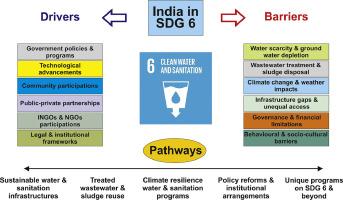Drivers and barriers towards achieving SDG 6 on clean water and sanitation for all - an Indian perspective
引用次数: 0
Abstract
Access to clean water and sanitation is a fundamental requirement for sustainable development. However, many low and middle income countries, such as India, continues to face significant challenges in achieving Sustainable Development Goal 6 (SDG 6), i.e., access to clean water and sanitation. Despite enormous initiatives taken by India, issues such as groundwater depletion, water pollution, and sanitation gaps persist. Population growth, urbanisation, and industrial expansion have put pressure on water resources, reducing water quality and sanitation services. This paper assesses the key barriers and drivers influencing India’s efforts and on the way forward to achieve the global 2030 Agenda. The present study follows the PRISMA methodology approach, combining secondary data, policy reviews, case studies, and government reports to assess the progress, barriers, and future outlook for SDG 6 in India. The key findings revealed that India's major drivers to SDG 6 are substantial progress in toilet construction,water supply expansion through government missions, technological breakthrough, public awareness campaigns, and public-private partnerships. Key barriers to achieve SDG 6 include inadequate wastewater treatment capacity, over-extraction of groundwater, rapid population growth, the adverse effects of climate change on water availability and sanitation infrastructure. Strengthening regional institutions, developing climate-resilient infrastructure, and innovative financing models could accelerate progress towards SDG 6. Additionally, the study recommends water and sanitation courses in the school curriculum and policy reforms, could help in realizing SDG 6 by 2030.

实现可持续发展目标6关于人人享有清洁水和卫生设施的驱动因素和障碍——印度视角
获得清洁用水和卫生设施是可持续发展的一项基本要求。然而,许多低收入和中等收入国家,如印度,在实现可持续发展目标6(可持续发展目标6),即获得清洁水和卫生设施方面继续面临重大挑战。尽管印度采取了巨大的举措,但地下水枯竭、水污染和卫生差距等问题仍然存在。人口增长、城市化和工业扩张给水资源带来了压力,降低了水质和卫生服务。本文评估了影响印度努力和实现《2030年全球议程》前进道路的主要障碍和驱动因素。本研究采用PRISMA方法,结合二手数据、政策审查、案例研究和政府报告,评估印度可持续发展目标6的进展、障碍和未来前景。主要调查结果显示,印度实现可持续发展目标6的主要推动力是厕所建设方面的实质性进展、通过政府任务扩大供水、技术突破、公众意识运动和公私合作伙伴关系。实现可持续发展目标6的主要障碍包括废水处理能力不足、地下水过度开采、人口快速增长、气候变化对供水和卫生基础设施的不利影响。加强区域机构、发展气候适应型基础设施和创新融资模式可以加快实现可持续发展目标6的进程。此外,该研究建议在学校课程和政策改革中加入水和卫生课程,有助于到2030年实现可持续发展目标6。
本文章由计算机程序翻译,如有差异,请以英文原文为准。
求助全文
约1分钟内获得全文
求助全文

 求助内容:
求助内容: 应助结果提醒方式:
应助结果提醒方式:


